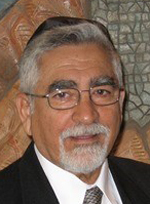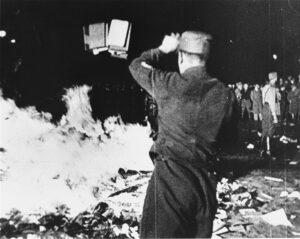By Dorian de Wind

AUSTIN, Texas — If you thought that book burnings were a barbaric relic of the Middle Ages, think again.
In the 1930s, in Nazi Germany, Austria and, later, in occupied territories, the Nazis conducted massive burnings of books they felt contained anti-Nazi ideology – including books written by Jewish authors, one of them Sigmund Freud.
Perhaps most infamous were the massive, May 1933, Berlin book burnings, when more than 45,000 “Un-German” books and journals were publicly burnt, including “works on intersexuality, homosexuality, and transgender topics.”
Albeit not in such a large scale, occasional book burnings have continued well into the 21st century.
As recently as November 2013, “once again, books [were] burning in Europe” when a neo-Nazi group in Hungary, on the anniversary of Kristallnacht, lit up the sky with a pyre of burning books written by Jewish and other “transgressive authors,” including books written by Jewish poet Miklós Radnóti, who was murdered by the Nazis during the Holocaust.
In late January of this year, the Tennessee McMinn County school board banned the Pulitzer Prize-winning graphics novel Maus from the county’s eighth-grade curriculum. Maus is the haunting story by Art Spiegelman about surviving the Holocaust, based on interviews with his own father.

Right on cue, a week later, a pastor led a good, old-fashioned, medieval book burning in a Nashville, Tennessee suburb to fight “demonic influences.” The condemned books included copies of the Harry Potter and Twilight series.
Even more recently, a suburban Fort Worth school district removed Anne Frank’s Diary: The Graphic Adaptation from library shelves and debated whether the book should be banned. Fortunately, unprejudiced minds prevailed, and the book was returned to the shelves.
One of the key findings in Pen America’s latest report on school book bans during the 2021-2022 school year is that among the 1,648 unique titles in the index, “674 titles (41 percent) explicitly address LGBTQ+ themes or have protagonists or prominent secondary characters who are LGBTQ+ ,” including “a specific subset of titles for transgender characters or stories…” Sounds familiar?
The Spanish author Antonio Iturbe writes, “Throughout history, all dictators, tyrants, and oppressors, whatever their ideology—whether Aryan, African, Asian, Arab, Slav, or any other racial background; whether defenders of popular revolutions, or the privileges of the upper classes, or God’s mandate, or martial law—have had one thing in common: the vicious persecution of the written word. Books are extremely dangerous; they make people think.”
But just as there are people, organizations, even governments who would ban the written word for ideological, political, social or religious reasons, there are those who – throughout history — have defended it, protected it, even with their life.
One such person and her story are superbly chronicled by Iturbe in his book The Librarian of Auschwitz, where his protagonist, a brave 14-year-old Czech Jewish girl, Dita Kraus, imprisoned with her father and mother at the Auschwitz-Birkenau death camp, assumes the awesome responsibility of becoming the secret custodian and librarian for the equally secret, smallest, perhaps most dangerous library in the world. A hidden “library” at the Auschwitz-Birkenau death camp consisting of eight precious books, smuggled into the camp at significant risk. The discovery of just one page of one book would have been punished by death. Especially since one of the books was a treatise titled New Paths to Psychoanalytic Therapy by a certain Jewish professor named Sigmund Freud.
In the first chapter of The Librarian, Iturbe makes both the danger of possessing these books and the fear of the Nazis for them abundantly clear, “They are holding something that is absolutely forbidden in Auschwitz. These items, so dangerous that their mere possession is a death sentence, cannot be fired, nor do they have a sharp point, a blade or a heavy end. These items, which the relentless guards of the Reich fear so much, are nothing more than books: old, unbound, with missing pages and in tatters. The Nazis ban them, hunt them down.”
The eight books, some with missing pages, some held together by a few threads, most of them badly worn and stained, were a source of hope, diversion, enlightenment, even fleeting happiness for the children of the Kinderblock (children’s block), to whom the books were read or enacted by fellow prisoners. Children who were destined to be murdered in the gas chambers a few days, weeks or months later, depending on when they were “selected.”
Of course, The Librarian is about more than the tiny library.
Iturbe spares no details when describing the macabre mission of Auschwitz-Birkenau, the intolerable horror, evil and degradation experienced by its “occupants,” including encounters with the infamous “Angel of Death,” Dr. Josef Mengele, and a glimpse into his gruesome “experiments.”
But we also read about extraordinary courage, determination, will to survive, hope, love between parents and their children and siblings, even of budding romances — as it is so well said on the inside jacket of Iturbe’s book, “From one of the darkest chapters of human history, comes an extraordinary story of courage and hope.”
The Librarian is not a new book. It was originally published in Spanish in 2012 and (excellently) translated into English in 2017 by Lilit Thwaites.
Dita Kraus survived the horrors of Auschwitz and lives happily in Israel. She is now a young 93 and recently (2020) published her own memoir, A Delayed Life, where she recalls her stint as “the librarian of the smallest library in the world,” and describes her life “After Auschwitz.”
Her husband, Otto Kraus, now deceased, was a “counsellor” at the Children’s Block where Dita was the librarian. Like Dita, he survived the horrors of Auschwitz. They reunited after the war and married in 1947.
In 2020, Otto Krause also published his autobiographical novel based on his experiences at the Czech “Family Camp” in Auschwitz-Birkenau, The Children’s Block.
Written in three different styles and from three different viewpoints, all three books are a must-read for anyone interested in this very real, sometimes depressing, always inspiring Holocaust story.
*
Dorian de Wind is a retired U.S. Air Force officer and a writer. This article appeared initially on The Moderate Voice website, with which San Diego Jewish World trades stories under auspices of the San Diego Online News Association.